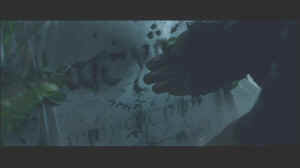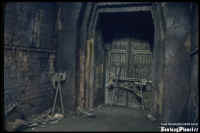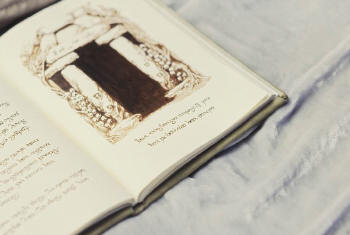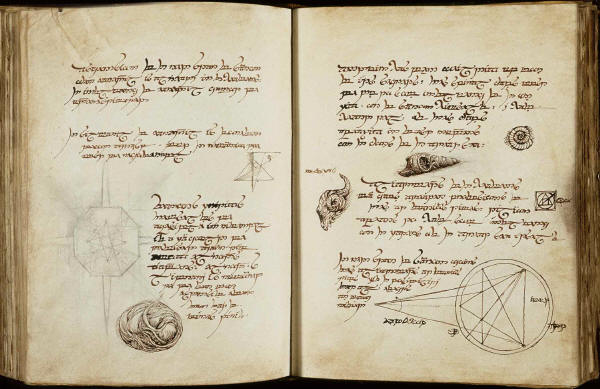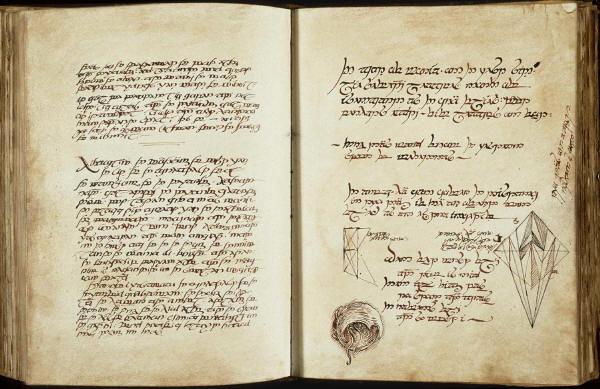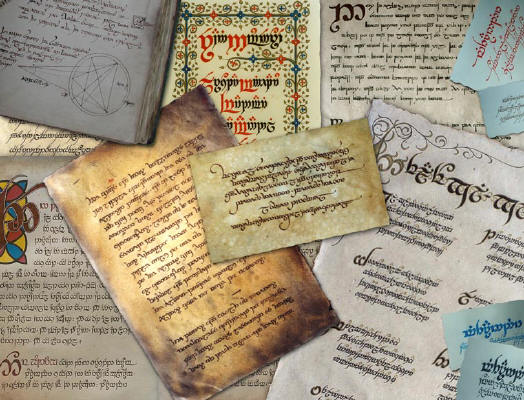
edited by Ryszard Derdzinski
Below I present the Elvish inscriptions which can be seen on the walls, tombs, artifacts, etc. found in The Lord of the Rings movie trilogy. Some of the inscriptions were made by David Salo, but the author of many of them was Daniel Reeve, Calligraphy Expert in the LotR movie. Daniel Reeve's mode of writing is here described as simplified tengwar and cirth systems.
Sindarin
1. Onen i-Estel... or Gilraen's Tomb Inscription (by David Salo)
Khuzdul
2. Mazarb Zigintarâg or Mazarbul Inscription (by David Salo)
3. Gabil gund Mazarbul or Collection of Mazarbul Wall Inscriptions (by David Salo)
English
4. Zirakzigilul or Mazarbul Wall Inscription (by Daniel Reeve)
5. Of Túrin Turambar or Imladris Book Inscription (by Daniel Reeve)
6. Fall of Gil-galad or Imladris Inscription (by Daniel Reeve)
7. Imladris Fresco or Sauron's Fall (by Daniel Reeve)
8. We cannot get out... or Mazarbul Book Inscription (by Daniel Reeve)
9. The Balrog Inscription or Saruman's Book (by Daniel Reeve)
10. The Ring of Barahir or Aragorn's Heirloom (by Daniel Reeve)
11. The Book of Arwen or The Paths of the Dead Inscription (by Daniel Reeve)
12.
Maps (by Daniel Reeve)
![]()
13.
Saruman's Book from Isengard (by Daniel Reeve)
![]()
14. Herbal from the Houses of Healing (by Daniel Reeve)
15. Collage of the tengwar
inscriptions (by Daniel Reeve)
![]()
1. Gilraen's Tomb Inscription.
language of inscription on the tomb: Sindarin
writing system: Tengwar (Standard Mode)
author: David Salo
Florian "Lothenon" Dombach from Germany sent us this very interesting photo from the extended DVD version of FotR (for details see here).

Gilraen
Onen i estel edain
ú-chebin estel anim
It seems to be the tombstone of Gilraen, Aragorn's mother.
It is quite obvious that this Sindarin text comes from the well known linnod from Appendix A in The Return of the King: Onen i-Estel Edain, ú-chebin estel anim 'I gave Hope to the Dúnedain, I have kept no hope for myself.' These were the last words Aragorn heard from his mother.
It is remarkable that the diphthongs are written full with carriers and the variable s-tengwa is used as Christopher Tolkien often did (a in most full-modes).
language of inscription: Khuzdul
writing system: Angerthas Moria [modified by Daniel Reeve]
author: David Salo
Photo from the Czech website Film Pán prstenu. Runic inscription deciphered by Patrice Blancho.

Mazarb
· Zigintarâg · Khazaddûmul
'Records [of] Long-beards [= Dwarves] of Khazad-dûm'
mazarb 'records'; cf. mazarbul 'of records'
Zigintarâg n. 'Long-beards'; it should rather be Sigin-tarâg.
Khazaddúmul adj. 'of Dwarrowdelf'
3. Mazarbul Wall Inscriptions.
language of inscriptions: Khuzdul
writing system: Angerthas Moria
author: David Salo
David Salo in Elfling message from November 30, 2002 presented background and meaning of the Moria inscriptions prepared by himself: "In May of 1999, I was asked to provide some translations and renditions into a mode of Angerthas for the runic lettering that would appear on the walls of Moria. I worked with John Howe and Grant Major on this; Grant wrote the texts he wanted rendered into Khuzdul (to be accurate: part Khuzdul, and part my own inventions), and I faxed back transcriptions into cirth. It was a few days' work, and then of course the inscriptions had to be turned into actual artifacts that would give the flavor of the Dwarvish civilization in Moria."
Here are inscriptions in Khuzdul prepared by David Salo. I have tried to find them in the know photos from Mazarbul. The part of inscription seen on the photo is printed in red. Photos with identified runes come from Eris Caffee (Moriel).
3.1.
Gabil
gund Mazarbul Sigin-turgul Khazaddûmul.
Durin Uzbad zahra.
'Great Chamber of Records of the Longbeards of Khazad-dûm. Lord Durin built (it).'
All of this is actually attested Khuzdul (though much only in proper names), except for zahra, which is back-formed from -zahar 'building' in Tumunzahar 'Hollowbold', and turgul, which relates to tarâg 'beards', as khuzdul 'of dwarves, dwarvish' relates to khazâd 'dwarves'. Other inscriptions may read (I do not know if all of them were created or not).
3.2.
Lai Khazaddûm,
zibdîn Durin Ulganul
'Behold Khazad-dûm, realm of Durin the Deathless*'
* It seems that the constructors of the
gate have transcribed into Angerthas the English text and not its
Khuzdul original (!).
Lai 'Behold' is an invention;
zibdîn is also an invention,
backformed from uzbad, according to the
pattern of khizdîn (in Nulukkhizdîn 'Dwarf-dwelling on the
Narog', the old Dwarvish name for Nargothrond).
I forget exactly what the thinking was behind ulganul, but it seems to
have the adjectival ending -ul, and probably a privative prefix as
well.
3.3.
Lai
Khazad-dûm zai Azanulbizar, Zibdîn Durinônul
'Behold Khazad-dûm by Azanulbizar, realm of Durin's sons'
zai 'by, at'; an invented preposition;
Durinônul: from the invented suffix -ôn "son".
3.4.
Durin
[certh for 3] Uzbad Khazaddûmu
'Durin III, lord of Khazad-dûm'
Straight Khuzdul.
3.5.
Durin mabazgûn au Abzag Durinu & [certh for "and"] Náin
Durinul Abzag Durinu
ya bazghu
'Durin slain by Durin's Bane, and Náin Durin's son,
Durin's Bane also slew him'
mabazgûn "slain", from an invented root bazaga with a participial prefix ma- (which I imagined to be seen in mazarbul) and a personal suffix -ûn (cf. the Khuzdul name for Gandalf, Tharkûn "staff-man");
au 'by (instrumental)': also invented;
abzag 'bane, slayer': also invented from the same root bazag;
Durinu: takes -u as the suffix for an objective genitive;
ya 'also': invented;
bazghu: past tense form bazg + 3rd singular masculine object suffix -hu.
3.6.
Thrór Rayad Dáinu; Rakhâs bazghu; Azog wakrish shathûrhu
'Thrór Heir of Dáin; Orcs slew him; Azog cut off his head'
rayad 'heir' is invented, presumably from a root rayada 'succeed' or the li ke;
wakrish: from a root karasha 'cut', wa- probably being an adverbial prefix 'off, away';
shathûr is attested in Bundushathûr 'Cloudyhead'; -hu is a 3rd singular masculine possessive suffix.
3.7.
Frerin Thráinul, Mabazgûn zai Azgâr Azanulbizarul,
zai shakâl
Kheled-zâramu
& Fundin mabazgûn
'Frerin Thráin's son, slain in the Battle of Azanulbizar,
on the shores of
Kheled-zâram, and Fundin slain'
azgâr: "battle", an invention;
shakâl: "shores", invented, according to the plural pattern of
khazâd.
3.8.
Gabil Azgâr Gundabadul & Ningulul; Mernak Mabazgân
'The great Battle of Gundabad and Gladden; remember the Dead'
Ningul 'Gladden'; an invention, supposed to resemble Elvish Ninglor;
mernak 'remember', also an invention; I forget the exact reasoning
behind
this particular form, perhaps meren "remember" plus an imperative
suffix, o
r a
prefix me- (plural?) plus a root ranaka. I suppose it is ironic that I
ha
ve
forgotten the root for remember!
3.9.
Ganâd Barazinbarul
'(The) mines of Barazinbar'
ganâd, plural of
gund (as in Felak-gundu 'cave-hewer'), on the
model of
the plural khazâd.
3.10.
Azgâr Azanulbizarul
'(The) battle of Azanulbizar'
3.11.
Zahar Durinul
'(The) house of Durin'
zahar
'building, house', again as in Tumunzahar.
David Salo adds: "Again, the wording here is that of Grant Major, the renditions into neo-Khuzdul are mine (as was the transcription into cirth). I should add that my construction of neo-Khuzdul (or pseudo-Khuzdul, if you prefer) changed over time, and that the constructions I used in the soundtrack differed in some particulars; in particular, I elaborated the ve rbal system a good deal more and in some different ways than the examples above suggest."
language of inscription on the wall: English
writing system: Angerthas Moria [modified by Daniel Reeve]
author: Daniel Reeve or David Salo
(see also this website)
Not all Moria inscriptions are in Khuzdul (language of the Dwarves). Some of them are in English transcribed into Dwarvish runes. Their author is probably Daniel Reeve. Below I present a well known Moria wall from Casa Loma exhibition analyzed by Anglin Turcam. It contains a long English text in cirth runes that was deciphered by Andrew Durdin on ELFLING:

|
|
|
|
| Wall 2 | Wall 3 | Wall 4 |
lor nogrodul & ....
el watch tower established at highest peak
nta zirakzigilul with star from thirtieth sall
second age five hundred of the of the fol
fathoms gold smelter built built
the estblishment moriaul below below
return for silver & elves trade
[eo tab..shyd???] & the dimril sunk to fourty
kheled Zaramul & thuz great gate
durinul ened luin settle in the five hu
one thousand & twenty news of fall smelt
forses sauronul army gates to moria t mo
service of lorien elves trade .... belegost
being second level shaft sunk to fourt establish
.... seventy two great gate .... with sta
....five hu.n... forty of......... ...
..o..s... gold smelter kheled zara....
..........ment moria. .......
It is quite obviously in English; the for silver is what I was able to read to the left of Pippin's head in the scene from the trailer. One weird thing is the use of -ul in moriaul, durinul, sauronul in an English text: -ul means probably 'of'; also strange is the repetition at the end of the second, third, and fourth lines.
language of inscription in the book: English
writing system: Tengwar [modified by Daniel Reeve]
author: Daniel Reeve
This photo was presented in the DVD Extended Edition of FotR (Disc 3). It shows an inscription devoted to Túrin Turambar (a hero from the First Age). The book with inscription comes from Elrond's library. Compare this text with UT:135. Daniel Reeve, author of this inscription, changed a bit the text by Tolkien, but the general sense is the same.
Túrin Turambar
Therefore crossed the water once more desiring to recover his
sword and to look upon his foe; and he found him stretched
at his length; and rolled upon one side; and the hilts of
Gurthang stood in his belly. Then Turambar seized the hilts
and set his foot upon the belly, and cried in mockery of the
dragon and his words at Nargothrond:
Hail Worm of Morgoth; well met again;
Die now and the darkness have thee; thus is
Túrin son of Húrin avenged.
6. Fall of Gil-galad Inscription.
language of inscription in the book: English
writing system: Tengwar [modified by Daniel Reeve]
author: Daniel Reeve
This photo was presented in the DVD Extended Edition of FotR (Disc 3). It shows an inscription devoted to Gil-galad (an Elvish King from the Second Age). The inscription comes from Elrond's library. This text is probably the extended version of the Fall of Gil-galad in The Fellowship of the Ring book.
7. Imladris Fresco Inscription.
language of inscription in the book: English
writing system: Tengwar [modified by Daniel Reeve]
author: Daniel Reeve
This photo was presented in the DVD Extended Edition of FotR (Disc 3). It shows an inscription on the wall of Imladris devoted to Sauron's fall from the hands of Isildur.
... fall of Sauron on the slopes of Orodruin
language of inscription in the book: English
writing system: Angerthas Moria and Tengwar [modified by Daniel Reeve]
author: Daniel Reeve
A.
 |
Florian
"Lothenon" Dombach sent us a collage of screenshots from
the FotR movie with a page of the book Mazarbul. It can be seen that it is
almost exact copy of J.R.R. Tolkien's picture with the third page of the
Book of Mazarbul (cf. J.R.R. Tolkien: Artist and Illustrator, p. 161).
Left Photo from Brian Sibley's The Lord of the Rings - The Making of the Movie Trilogy. Below Photo collage from the movie. |

This is what he managed to translate:
we cannot get out. we cannot get out.
they have taken the bridge & second hall.
fraar & lóni & náli fell dhere
bravely while dhe rest retreated to
mazarbul. we still hold the chamber
but hope [i]z fading now. óins
party went 5 days ago but today
only 4 returned. the pool [i]z up to the wall
at westgate. the watcher in the water tók
óin ---- we cannot get out. the end
comes són. we hear drums drums in
dhe dép.
The tengwar below seem to say they are coming using full-vowels mode.
B. Adam Cook sent us more screenshots of the Book of Mazarbul. This on the right shows the same page which was analyzed above. Interesting is the left one with quite new inscription in English.
The
proper transcription of this text was sent by Florian Dombach. It is written
in tengwar full mode seen in the Brogan letter:
Cirth:
and so we come to our final hope
Óin [i]z going to the westgate to see
if we can escape dhat wai
Tengwar:
The
orcs have taken all the lower
levels and the upper halls to the
fifth level. Our stores of food
in(?) running low and we have no
water to drink. Unless Oin
can find a way out at the west
gate we are doomed wether the
orcs get us or not.
Moria
will not be ours
9. The Balrog Inscription.
language of inscription in the book: English
writing system: Tengwar [modified by Daniel Reeve]
author: Daniel Reeve
Drawing of balrog: Allan Lee
This photo was presented in the DVD Extended Edition of FotR (Disc 2). It shows an inscription devoted to Moria and cruel Balrog living there. We can see the reproduction of known Tolkien's drawing of Moria Gate with Sindarin inscription with tengwar letters. Compare it with The Fellowship of the Ring book.
10. The Ring of Barahir Inscription.
language of inscription in the book: English
writing system: Tengwar [modified by Daniel Reeve]
author: Daniel Reeve
This photo was presented in the DVD Extended Edition of FotR (Disc 3). It shows an inscription devoted to Aragorn's ring (called The Ring of Barahir). The book with inscription comes from Saruman's Isengard. compare the text of the inscription with The Silmarillion, p. 189.

The Ring of Barahir and Felegnd [?]
The ring was like to twin serpents whose
eyes were emeralds, and their heads met beneath
a crown of golden flowers, that
the one upheld and the other devoured. That was
the badge of Finarfin and his house.
language of inscription in the book: English
writing system: Tengwar [modified by Daniel Reeve]
author: Daniel Reeve
This photo comes from the German website Herr der Ringe. It shows the Elvish book about the Paths of the Dead. We could see this book in The Return of the King in the scene with Arwen in Rivendell. Compare the text of the inscription with The Return of the King, p. 53 (Malbeth the Seer's Words). Thanks to Adaneth and Lothenon for deciphering this inscription.
|
at the Stone of Erech they shall stand again and hear
there a horn in the hills ringing shall call them from the grey
twilight, the forgotten people?
oath they swore. shall drive him: he shall pass the |
[under the picture]
The northern entrance to the Paths of the Dead. |
language of inscriptions on the maps: English, Sindarin, Khuzdul, Orkish
writing system: Tengwar [modified by Daniel Reeve]
author: Daniel Reeve
The maps come from The Lord of the Rings - The Making of the Movie Trilogy by Brian Sibley and The Lord of the Rings - Weapons and Warfare by Chris Smith and from Daniel Reeve's website. There are more maps in the mantioned book.

language of inscriptions in the book: English
writing system: Tengwar [modified by Daniel Reeve]
author: Daniel Reeve
The picture has been provided by Urambo Tauro (thanks!). The book occurs in The Two Towers EE. This two pages read:
|
Page 1
ascension of the red star of sauron
|
Page 2
anduin has been yeilding up more |
|
|
|
|
Page 3
(days?) to the (?e??e?t?) of both elves
|
Page 4
the gate of moria on the west side
|
|
|
|
|
Page 5
and more manflesh to satiate the
|
Page 6
moria
|
|
|
|
|
Page 7
the
west gate of moria has stood |
Page 8
narvi and celebrimbor
|
language of inscriptions in the book: English
writing system: Tengwar [modified by Daniel Reeve]
author: Daniel Reeve
The picture comes from The Lord of the Rings - The Making of the Movie Trilogy by Brian Sibley. It shows a herbal from the Houses of Healing which will take important part in The Return of the King Extended DVD Edition. Thanks to Lothenon and Adaneth for deciphering this inscription.
|
Healing properties of common herbs Autumn Crocus a traditional herb for the treatment of gout [an?] infusion of the leaves in boiling water should be administered daily. Tanacetum Vulgar [...] [...] [...] [...] flowers between july and september [...] the pads and [...] [...] wood(?) [...] cooking to [...] |
15. Collage of the tengwar inscriptions.
language of inscriptions in the book: English
writing system: Tengwar [modified by Daniel Reeve]
author: Daniel Reeve
The picture comes from Daniel Reeve's website. We can see here (from top left to bottom right): Saruman's Book (Isengard), Númenórë Kings' Chart (Rivendell), The Rings Description (Isengard?), Mithrandir Lettering I, Mithrandir Lettering II, Imladris Book Inscription (Rivendell), Akallabêth Text, Lúthien Tinúviel Inscription (Rivendell?), Fall of Gil-galad Inscription (Rivendell), Mithrandir Lettering III and Mithrandir Lettering IV.
